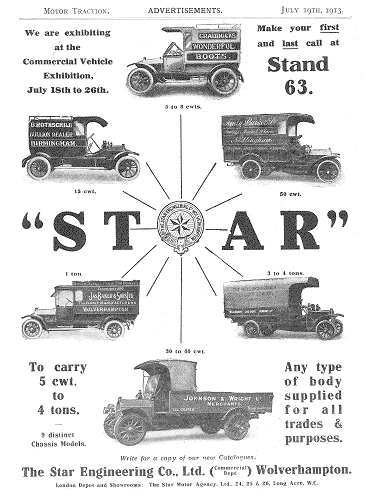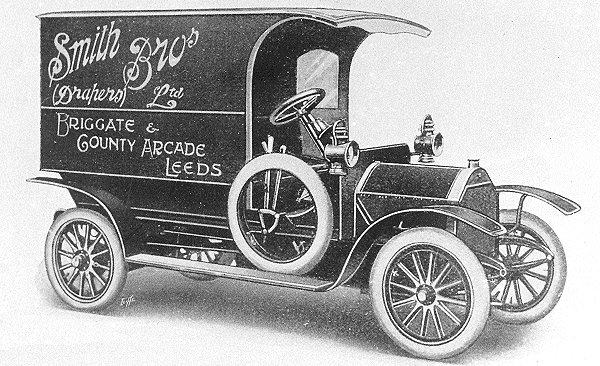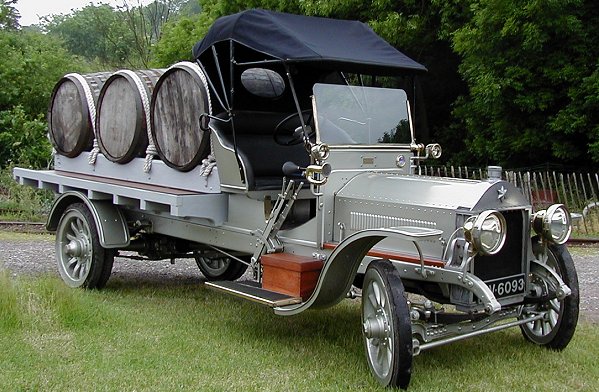| Wolverhampton car manufacturer Star, based in Frederick
Street, began producing commercial
vehicles as early as 1902. The first van
was built on their standard car chassis, and could of carry a load of
6 cwt. It was said to be the first van to have a totally enclosed cab, and
although few can have been sold, it was the first of many
types of vans and lorries that would be built by Star.
Within 5 years sales were significant, and Star was
supplying vans and lorries to many businesses, including
Lever Brothers, which had a fleet of 19 vans at Port
Sunlight. |
|

An advert from 1913. |
Tragedy struck in 1913 when a fire destroyed the body
shop, including many of the vehicles that had been prepared
in readiness for the Commercial Vehicle Show at Olympia. The
range of vehicles included vans and lorries with capacities
of 5 cwt. to 4 tons. Unfortunately only a single one ton
van, and a 30/40 chassis were available for the show.
The 1913 range included an 8 cwt. chassis that sold for
£230.15s, a 20 cwt. chassis that sold for £280, or £310 with
pneumatic tyres, and a 4 ton chassis with a selling price of
£550. There was also a 2½ ton
chassis with double reduction gears on the rear axle. |
| A 1 ton van from 1914.
Courtesy of the late Jim Boulton. |
 |
 |
A 30 to 50 cwt. lorry from
1914. Courtesy of the late Jim Boulton. |
| The First World War
Shortly after the outbreak of war in 1914, the Star
Engineering Company Limited became a controlled
establishment, with output devoted to the war effort. Some
commercial vehicles were supplied to the British, French and
Russian armies; and a large order was obtained for
ambulances for the British Army in Mesopotamia. Star’s main
effort consisted of the production of aircraft wings and
parts for mines. This did not fully occupy the works and so
horse-drawn carts and wheels were also made.
In 1918 the company accepted an order for four hundred
V8, 80hp. Renault engines. The V8 engines were air-cooled
and had a 90 degree angle between the 'V'. They were fitted
to DH6 trainers, but only 12 had been built by the end of
the war, when all military orders were cancelled. During the
war Star also produced a number of vehicles for use as
Marconi portable wireless stations. They were designed for
field use, and contained wireless equipment made by the
Marconi company. |

A 50 cwt Star lorry that was supplied
to several allied armies during the war. Courtesy of the
late Jim Boulton. |

A 50 cwt Star lorry at the front. From
an old postcard, courtesy of the late David Evans. |
|

A Star-Marconi portable wireless
station. Courtesy of the late Jim Boulton. |

A Star-Marconi portable wireless
station chassis showing the Marconi generator. Courtesy of
the late Jim Boulton. |

A postcard produced to promote the
Star-Marconi portable wireless station. From an old
postcard, courtesy of the late David Evans. |
| From the Wolverhampton Chronicle,
Wednesday 3rd March, 1915:
THE "STAR" AT THE FRONT.
A GREAT
COMPLIMENT TO WOLVERHAMPTON
ENTERPRISE.
Wolverhampton’s products are
giving splendid service to the nation under the
stress and strain of war, and none more so than the
motor vehicles turned out by the Star Engineering
Company Limited. The Russian Government found Star
quality as good as Star reputation, so that their
orders for chassis were continued until the blocking
of the White Sea by ice. At present large numbers of
lorries (similar to the one shown in the photograph)
are being turned out to the order of the French
Government, while the firm has a standing order from
the British Government (as has previously been
stated in the “Express and Star”) to deliver as many
vehicles as possible until further notice. From
these facts it will be realised that the works are
being tested to the limit of their output.

The Star Company has also
supplied a number of Red Cross Ambulance vehicles. A
Marconi vehicle has had rather an adventurous
career, in as much as it was rushed across to
Antwerp in a special boat at the time of the German
invasion. The car gave excellent service, and
remained on duty till the last moment, so that it
was only removed out of the town just in time to
avoid capture.
It is very gratifying to the
company to hear that out of the large numbers of
vehicles that have been supplied, and are now
working under the worst of conditions at the front,
not one has given cause for complaint. On the
contrary, testimonials of a glowing character have
been received from both private and official
sources. |
|
| A 10 cwt. light delivery van from
1914. Courtesy of the late Jim Boulton. |
 |
 |
A 2 ton van from 1914. Courtesy of
the late Jim Boulton. |
|

A 10 to 12 cwt. light delivery van,
powered by a 12-15 hp. engine. Selling price £285. |

A Star lorry from 1917. Courtesy of the late Jim
Boulton.
 |
An advert from around the end of
the First World War. |

John Marshall's 25 hp.,
50 cwt. Star lorry, at the
Black Country Living Museum in 2001.

Another view of John Marshall's Star lorry.
|

A final view of John Marshall's Star lorry. |
After the war, normal production of commercial vehicles
resumed. Initially only three chassis were on offer, a 30
cwt., a 2½ ton, and a 3 ton,
although others were soon available. 1927 saw the
emergence of the Star 'Flyer', a fast chassis, initially
intended for use as a low-loading passenger vehicle, but
also available for use as a van or lorry.
It was powered by a 3.2 litre, 6-cylinder overhead valve
engine, and equipped with vacuum servo brakes. It sold for
£645 and proved to be quite popular. |

A 25 cwt. Star van from 1925. Courtesy of the late
Jim Boulton.

The Later Years
Production at the factory peaked between 1921 and 1925, when
around 1,000 vehicles of all kinds were built each year.
By the time of the General Strike in 1926, Star cars had become extremely
expensive, compared with the competition. This would
eventually lead to the company’s decline. In 1927 only
105 cars left the factory.By 1928 with production still falling, Star found itself in a precarious
financial position. The company was rescued by Guy Motors, which took control through an exchange
of shares, though Star continued in existence as a separate company, now
called The Star Motor Company Limited. The reason for the take-over is
uncertain. It is possible that Guy wanted to re-enter the
luxury car market, or to acquire Star's most successful
commercial vehicle at the time, the 'Flyer', or even simply
to acquire a competitor.
One of the first major changes at the Guy/Star company
took place in 1929 with the closure and sale of Star's Frederick Street
factory, and a
move to the Showell Lane works, which had been built in 1920 and used as
a body shop. Vehicles could now be built under one roof, but the workforce was reduced to
around 250, and Guy dropped some of Star’s heavier commercial vehicles,
that were in direct competition with its own products.
Under Guy, the cars retained their quality build and high levels of
workmanship, but they were far too expensive for most people.
1930 saw the introduction of the ‘Comet’, ‘Planet’ and ‘Jason’ series.
1931 saw the introduction of another new model, the 'Little
Comet Fourteen', and two models with fabric bodies.
Unfortunately a small loss was made on the sale of every
vehicle, and Guy Motors found itself in financial
difficulties due to the recession, and couldn't afford to
equip the Bushbury factory with up-to-date machinery. Star
found itself in a desperate situation, which resulted in the
appointment of a Receiver in March 1932.
Spares and manufacturing rights were obtained by McKenzie and Denley,
of Birmingham, who continued selling spares and servicing
Stars into the 1960s. The Frederick Street factory was sold to James Gibbons (Windows)
Limited, and later to Chadd Castings Limited, which cast aluminium
components for a variety of uses, including vehicle parts for companies
such as Rolls Royce, Leyland DAF, Rover and Land Rover. The Bushbury factory was sold to Manley & Regulus,
makers of plumbing fittings, and later acquired by Delta
Metals. |
|